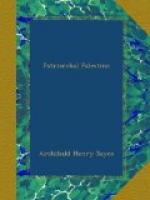When Ramses III. followed the retreating invaders of his country into Syria, it is doubtful whether the Philistines had as yet settled themselves in their future home. At all events Gaza fell into his hands, and he found no difficulty in marching along the Mediterranean coast like the conquering Pharaohs who had preceded him. In his temple palace at Medinet Habu he has left a record of the conquests that he made in Syria. The great cities of the coast were untouched. No attempt was made to besiege or capture Tyre and Sidon, Beyrout and Gebal, and the Egyptian army marched past them, encamping on the way only at such places as “the headland of Carmel,” “the source of the Magoras,” or river of Beyrout, and the Bor or “Cistern.” Otherwise its resting-places were at unknown villages like Inzath and Lui-el. North of Beyrout it struck eastward through the gorge of the Nahr el-Kelb, and took the city of Kumidi. Then it made its way by Shenir or Hermon to Hamath, which surrendered, and from thence still northward to “the plain” of Aleppo.
In the south of Palestine, in what was afterwards the territory of Judah, Ramses made yet another campaign. Here he claims to have taken Lebanoth and Beth-Anath, Carmel of Judah and Shebtin, Jacob-el and Hebron, Libnah and Aphek, Migdal-gad and Ir-Shemesh, Hadashah and the district of Salem or Jerusalem. From thence the Egyptian forces proceeded to the Lake of Reshpon or the Dead Sea, and then crossing the Jordan seized Korkha in Moab. But the campaign was little more than a raid; it left no permanent results behind it, and all traces of Egyptian authority disappeared with the departure of the Pharaoh’s army. Canaan remained the prey of the first resolute invader who had strength and courage at his back.
CHAPTER IV
THE PATRIARCHS
Abraham had been born in “Ur of the Chaldees.” Ur lay on the western side of the Euphrates in Southern Babylonia, where the mounds of Muqayyar or Mugheir mark the site of the great temple that had been reared to the worship of the Moon-god long before the days of the Hebrew patriarch. Here Abraham had married, and from hence he had gone forth with his father to seek a new home in the west. Their first resting-place had been Harran in Mesopotamia, on the high-road to Syria and the Mediterranean. The name of Harran, in fact, signified “road” in the old language of Chaldaea, and for many ages the armies and merchants of Babylonia had halted there when making their way towards the Mediterranean. Like Ur, it was dedicated to the worship of Sin, the Moon-god, and its temple rivalled in fame and antiquity that of the Babylonian city, and had probably been founded by a Babylonian king.
At Harran, therefore, Abraham would still have been within the limits of Babylonian influence and culture, if not of Babylonian government as well. He would have found there the same religion as that which he had left behind him in his native city; the same deity was adored there, under the same name and with the same rites. He was indeed on the road to Canaan, and among an Aramaean rather than a Babylonian population, but Babylonia with its beliefs and civilization had not as yet been forsaken. Even the language of Babylonia was known in his new home, as is indicated by the name of the city itself.




